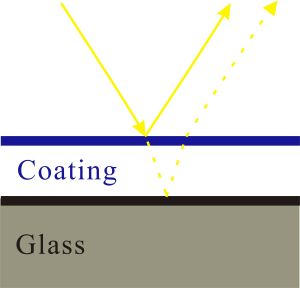Why are spectacles or camera lens so difficult to clean?
Why are spectacles or camera lens so difficult to clean?
LEE Boon-ying
Why are spectacles or camera lens so difficult to clean? It seems to get worse when an ordinary cloth is used, which tends to produce mult-coloured marks.
Most spectacles and camera lenses today are coated to reduce reflection. The coating produces another reflection on its own surface, which interferes with the original reflection from the glass surface, reducing the reflection as a result.

Recalling high-school or college science, the coating should be quite precisely made to a thickness of 1/4 of the wavelength of light (in the coating material). The coating thickness is of the order of 100 nm (nanometre).
When an ordinary cloth is used to rub grease off the glass, the grease becomes an additional coating with varying thickness. This produces multi-coloured reflections, because light is made up of different colours (i.e. different wavelengths). The 'rainbow' effect is similar to what we see when looking at a wet road with an oil film on it.

What is the proper way to clean the glasses?
Use the special cloth that comes with spectacles or camera lens. It is made of thin fibres that are good at picking up grease, rather than spreading it.
A wet method involves washing with soap or a little liquid detergent. Then rinse, and leave it to dry or dry with a clean linen. You can also go to an optical shop for such a service.
In the older days, properly coated lenses tend to have a purplish hue by reflected light. You no longer have this nowadays. Why is that?
Primarily this is because the condition for non-reflecting coating (i.e. thickness of 1/4 the wavelength of light in the coating material, see above) applies for one wavelength only, which is usually chosen to be one near the middle of the visible light spectrum. The reflection of red and violet light on either side is then somewhat larger.
These days multiple layers of coating made from different materials are used, which through careful design are capable of reducing reflection over a wide range of wavelengths.
Where does the energy go when light falls on a non-reflecting, or a so-called 'zero reflection' lens?
Because energy is conserved no light is destroyed. Less reflection simply means increased transmission in the lens.
Is there any coating that increases reflection rather than decreases it?
Naturally. Again the coating thickness has to be precisely made. Lenses of this kind may be used, for example, as beam-splitting mirrors to divide a beam of light into two parts. Less energy is lost this way than the use of a mirror, which absorbs energy during both transmission (within the mirror material) and reflection (from the thin metallic film on the back of it).
References:
[1] F.A. Jenkins and H.E. White, 'Fundamentals of Optics', McGraw-Hill, 4th edition, 1976.
[2] 'The last word', New Scientist, 27 August 2005.
[1] F.A. Jenkins and H.E. White, 'Fundamentals of Optics', McGraw-Hill, 4th edition, 1976.
[2] 'The last word', New Scientist, 27 August 2005.